Pantex Blog
Pantexans Attend National Honor Guard Academy
Each day, highly-trained first responders proudly don a Pantex firefighter or security police officer (SPO) uniform ready to respond to any potential emergency situations and contribute to the important Pantex mission.
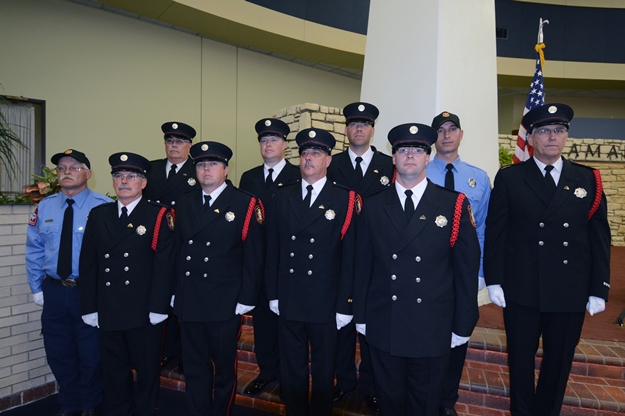
Last October, several of these Pantexans opted for more extensive training with the National Honor Guard Academy class hosted in Amarillo by Potter County Fire and Rescue. Ten members of the Pantex Fire Department (PXFD) Honor Guard and five SPOs graduated from the class after six days of rigorous training.
The Pantexans joined other Amarillo area firefighters and law enforcement personnel in an intense week-long “boot camp” with courses in basic drill and ceremonial movements, flag etiquette, uniform care, casket protocol and even a mock funeral service.
Attending the National Honor Guard Academy training sparked interest in creating a Pantex SPO Honor Guard and provided an opportunity for the PXFD Honor Guard to improve and formalize its already established procedures.
“We started looking for a standardized way to do things like in the military,” said Donovan Morgan, PXFD battalion chief and Honor Guard member. “We wanted to be able to blend into ceremonies with other first responders.”
Members of the PXFD established the Honor Guard in 2011 to show respect and compassion to families of fallen firefighters and law enforcement personnel. They developed their own operations manual, flag and uniform, which Morgan is quick to point out has no rank insignia.
“We might have different ranks in our day-to-day work, but there is no rank in the Honor Guard. We all come together to honor our fallen brother or sister,” Morgan said. “It’s not about us. Our main goal is to show respect to the family.”
The group offers fire service funerals at three response levels based on the nature of the death, and occasionally provides flag and color guard presentations for other official ceremonies.
In addition to supporting Pantex and local area memorial services and official ceremonies, the PXFD Honor Guard also travels on their own time and at their own expense to support services honoring first responders killed in the line-of-duty across the country. They have traveled as far as south as Houston and as far west as Prescott, Arizona. Each September, they even attend a ceremony at the International Association of Fire Fighters Fallen Fire Fighter Memorial in Colorado Springs.
Jody Baker, a Pantex firefighter/paramedic who died in a off-duty vehicle accident December 25, 2011, was very instrumental in organizing the PXFD Honor Guard. After Baker’s death, they were filled with a greater sense of duty and pride.
What began as a way for Pantex firefighters to honor fallen first responders and their families has become a living tribute to one of their own.
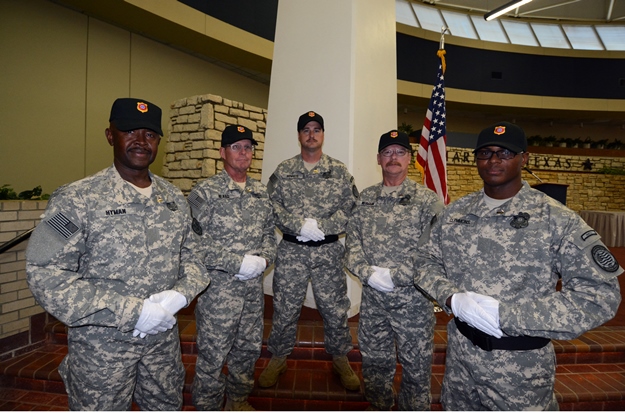
Pantex Honors Small Business of the Year
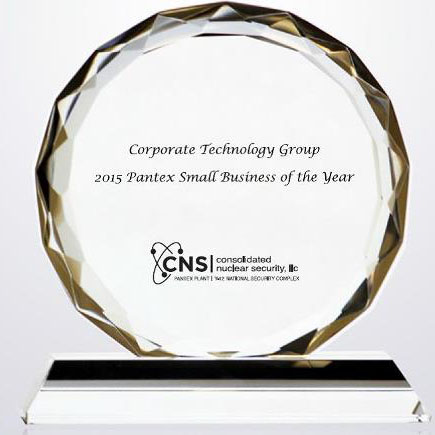
Recently, Pantex partnered up with the West Texas A&M Procurement Center and Small Business Development Center to provide local and regional small businesses with opportunities in the Federal arena at the 2015 Pantex Small Business Symposium.
Rick Palmer, Director of the WTAMU Procurement Center saw this program as a great opportunity to gather all the parties in one room and get down to the business of small business.
“The mission and goal…is to get great local businesses together with potential clients such as governmental agencies and their contractors. We were able to accomplish this by hosting a showcase event where the CNS Pantex managers met many local companies and their people,” Palmer said.
Presentations were made by Pantex, WTAMU, Small Business Administration, the city of Amarillo and its Mayor Paul Harpole, all designed to help walk attendees through the procurement process.
The highlight of the day was a ceremony to recognize the 2015 Pantex Small Business of the Year award, presented by Mayor Harpole and Caleb Pool, representing 13th Congressional District Representative Mac Thornberry’s office.
This year, the award went to Corporate Technology Group (CTG); a locally owned, Woman Owned Small Business, committed to excellence in all phases of business. They provide extraordinary customer service and in FY2014, CTG had a 95.1% overall success rating with Pantex for on-time delivery. CTG met or exceeded Pantex’s goals in almost all instances, negotiated with manufacturers and vendors to lower costs while still meeting required Pantex deadlines.
Monica Graham-Carlson, Pantex Small Business Program Manager, was pleased with the turnout and the commitment made to the small business entrepreneur.
“I think the event was a great success. Pantex is committed to including small businesses in contracting opportunities and believe this event allowed us to reflect on that commitment.”
Kids, Incorporated Honors Pantex with Championship Ring
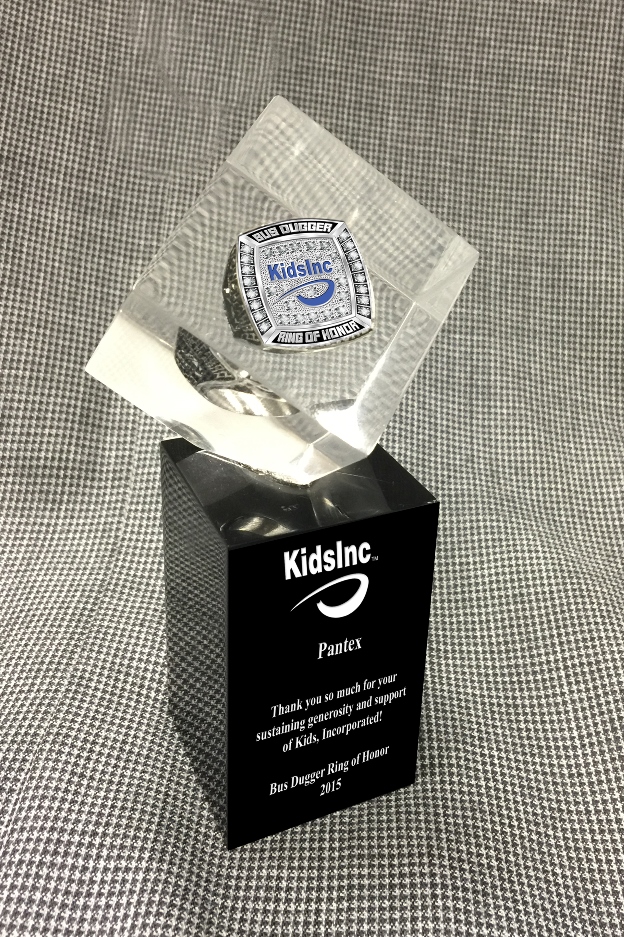
It is the single goal for every professional sports team…to win a national championship. The prestige and pride is usually accompanied by a one-of-a-kind championship ring that is one of the most prized possessions in all of sports.
Now, Pantex can claim a championship ring, but not for what was done on a field of dreams, well, not directly anyway. It’s a congratulatory gift designed to acknowledge contributions made by Pantex to Kids Incorporated which helps out thousands of local kids with sporting events all year long.
Receiving this championship ring isn’t based on catching a touchdown pass or hitting a home run. It’s about how well Pantex performed off the field and the charitable contributions provided off the field to Kids, Inc. To be a member of this “Ring of Honor,” the contribution column of a business’ score card has to total more than $10,000 in donations.
The ring itself is named after Bus Dugger, the very first coach at Kids, Inc. At 95 years young, Coach Dugger was on hand at the ring ceremony to present his namesake championship finger-sized trophies. In fact, about 60 different businesses were honored as Champions, due to their donations and investment made back into the youth of Amarillo and the surrounding areas.
In 2014, Kids, Inc. had almost 16,000 kids involved in their events. This year, as they celebrate their 70th anniversary, they decided to recognize those organizations and their employees who make these programs possible.
“Pantex was one of the first companies to step up and assist us financially when we began providing medals for the kiddos at the end of each sport," states Jimmy R. Lackey, President & CEO for Kids, Incorporated. “We have many, many volunteers who are employed at Pantex. We are so grateful for the support they provide to our organization."
Pantex Site Manager Michelle Reichert expressed appreciation for the honor and stressed Pantex's commitment to Kids, Inc.
“Pantex and its employees have been long-time supporters of Kids, Incorporated and being recognized with this ‘Ring of Honor’ is something everyone out at the site can be proud of and I gladly accept this on behalf of each and every employee at Pantex,” said Reichert.
Any athlete will tell you that receiving accolades at the end of a successful season is not what competitive sports is all about. It’s about promoting and building team work, having everyone focus on a single goal and performing up to the expectations of what you and your team members committed to doing long before the season began. That is what it takes to become a true champion. In this case, just like the kids on the field of any Kids, Inc. event, Pantex and its employees can also share those same goals as they received a championship ring for their efforts of giving back to the community.
Wild Pantex – The Swallows of Pantex
Article by Jim Ray, Pantex Wildlife Biologist/Scientist
Pantexans are quite familiar with the bird nests made of mud that adorn our buildings each spring and summer. You may even have these on your house, whether you live in town or in the country. The nests that are most numerous are made by swallows, although the Say’s phoebe and American robin also construct a nest made largely of mud, which also commonly occur on buildings and other structures.
At Pantex, two species of swallows are present during the nesting season: the barn swallow and the cliff swallow. Swallows are very beneficial birds, consuming a diet that includes a wide variety of flying insects. No, they are not going to wipe out mosquitoes in your neighborhood, but you can be sure that they are going to eat insects from sunrise to sunset.
The barn swallow is blue on top and has a rust-colored breast. It has a characteristic deeply-forked tail. Barn swallow pairs nest alone or in small, loosely-situated colonies. Its nests are bowl or cup shaped, and its interior is lined with grasses and then white feathers. Formerly a cave nester, the barn swallow now nests under eaves, on porches, in abandoned buildings, under bridges and in culverts. At Pantex, I’ve even seen them nest under a utility box erected on a post. Barn swallows incubate four to six eggs at a time, and usually raise two broods per year, rarely three.
The cliff swallow has a dark chestnut and blackish throat and a pale forehead. However, its square tail, buff-colored rump, colonial nesting habitat and gourd-shaped nest easily differentiate it from the barn swallow. This is the swallow of Capistrano! Formerly, this species was confined largely to overhangs on cliff faces, but now is also adapted to nest on the sides of buildings and under bridges and other protective “canopies.” Like the barn swallow, its nest is comprised of pellets of mud, but access to the nest is limited to a small entrance hole and short tunnel. The nest interior is lined with grass, feathers and hair, and contains two to six eggs at a time. Normally, only one brood is raised per year, rarely two. A colony of these birds may number in the hundreds, with nests crowded against each other.
By the way, many Panhandle residents erroneously refer to these two swallows as Purple Martins. Actually, the Purple Martin is in the swallow family, but is twice the size of either the cliff or barn swallow. East of the Rocky Mountains, if you see a Purple Martin nesting in any situation, but within the cavities of a man-made bird house/gourd, you have either made an error in identification or someone is going to get a note published in the literature! That is how rare and newsworthy such an observation would be! Unlike with cliff and barn swallows, where males and females resemble each other in coloration, the two sexes of Purple Martins differ in coloration. Only the after-second-year male is all blue black (approaching purple) in coloration.
Swallows are extremely valuable birds. For the most part, Pantex loves the service that these birds provide in terms of insect control. However, their nesting in certain situations is often despised due to the mess they can create. Normally, by the time they are really messy, the young are about ready to leave the nest. This is because they have grown into such “consumers” that waste cannot be hauled away fast enough by the parents, as is the case when the young are small. A sky-blue paint used under the eaves and porches at Pantex is showing promise of encouraging the birds to nest elsewhere. In theory, it gives the birds the feeling that there is not a protective overhang under which they could attach their nests. The jury is still out on this technique, but its use appears to be successful. The goal is that they will choose a place that is good for the birds and Pantexans alike.
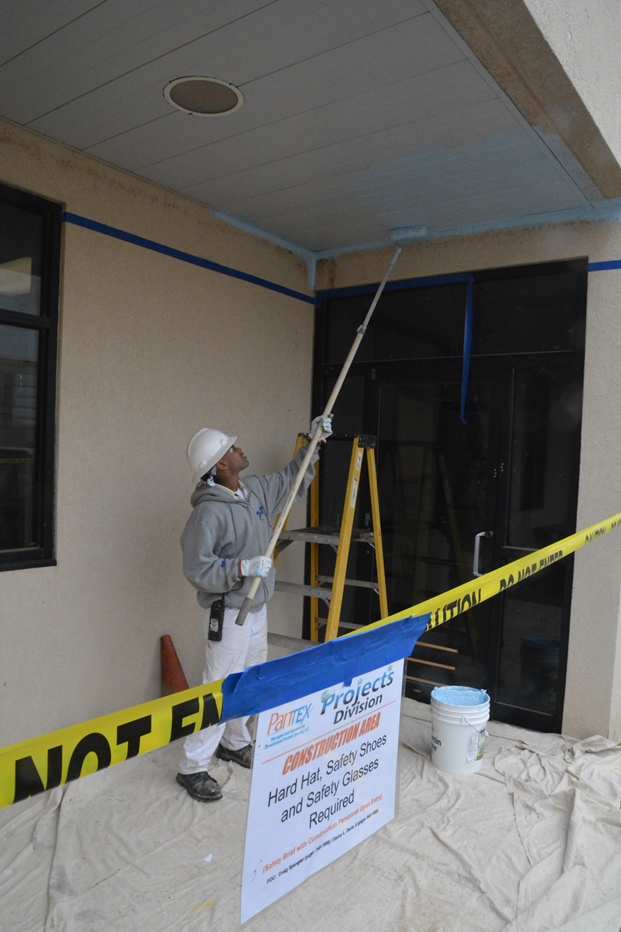
A Pantexan applies sky-blue paint to ward away barn and cliff swallows from placing their nests under the overhang of the building.
Pantex Employees Bowl for Kids’ Sake
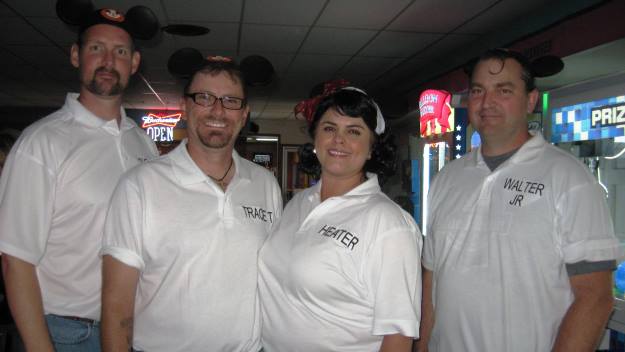
Pantexans are well known for their generosity and going “above and beyond” to help out in their communities and that spirit of giving was never more prevalent than at the recent Big Brothers Big Sisters (BBBS) Bowl For Kid’s Sake. Besides Consolidated Nuclear Security, LLC being a corporate sponsor for this year’s fundraiser, Pantex employees filled lane after lane with bowlers to help raise money and awareness for the mentoring program.
It’s an all-day event with teams coming and going at Western Bowl for bowling fun and bringing in sponsorships that go directly to the BBBS organization, which serves more than 250 young men and women in the Amarillo and Canyon area. Along with those successfully matched, at any one time, BBBS may have up to 150 little brothers and sisters on their waiting list, usually from single parent homes where a young man or woman might not get the one-on-one time with an adult that they need.
At absolutely no cost to the parent, the children, or “Littles” are signed up and then matched up with a “Big” who agrees to spend a few hours a week with their match. Their mission is to help children reach their full potential through professionally supported, one-to-one mentoring relationships. Through fund-raising efforts like Bowl for Kids’ Sake, they are able to keep the program up and running. It’s a huge undertaking for the staff at BBBS, but the rewards are worth every minute spent in fundraising.
“Bowl For Kids’ Sake is one of our agency’s largest fundraisers and accounts for over 30% of our annual budget. Proceeds from the event are dedicated to program costs that directly affect the lives of the children we serve. We are able to help more than 250 children participating in our programs, thanks to our Bowl For Kids’ Sake sponsors,” said Emily Shelton Nance, executive director, BBBS of the Texas Panhandle.
Pantex employees always make up one of the largest groups to be represented with multiple teams being the norm, rather than the exception. Having the site so highly represented is also something that BBBS never takes for granted, and is very thankful for when it comes time each year to let the bowlers roll a pair of games.
“Pantex has been a cherished supporter of Bowl For Kids’ Sake. In the last nine years, more than 147 teams have participated in Bowl and provided needed funding to serve virtually hundreds of children living in our community,” added Nance.
BBBS is planning new and diverse forms of fundraising through the coming months, but it’s a sure bet that Bowl for Kids’ Sake will continue on as usual, with a great feeling of accomplishment from everyone involved, including the Pantexans who will once again takes to the lanes to make a big difference and have a little fun for some “Bigs” and “Littles” who are the real winners.
